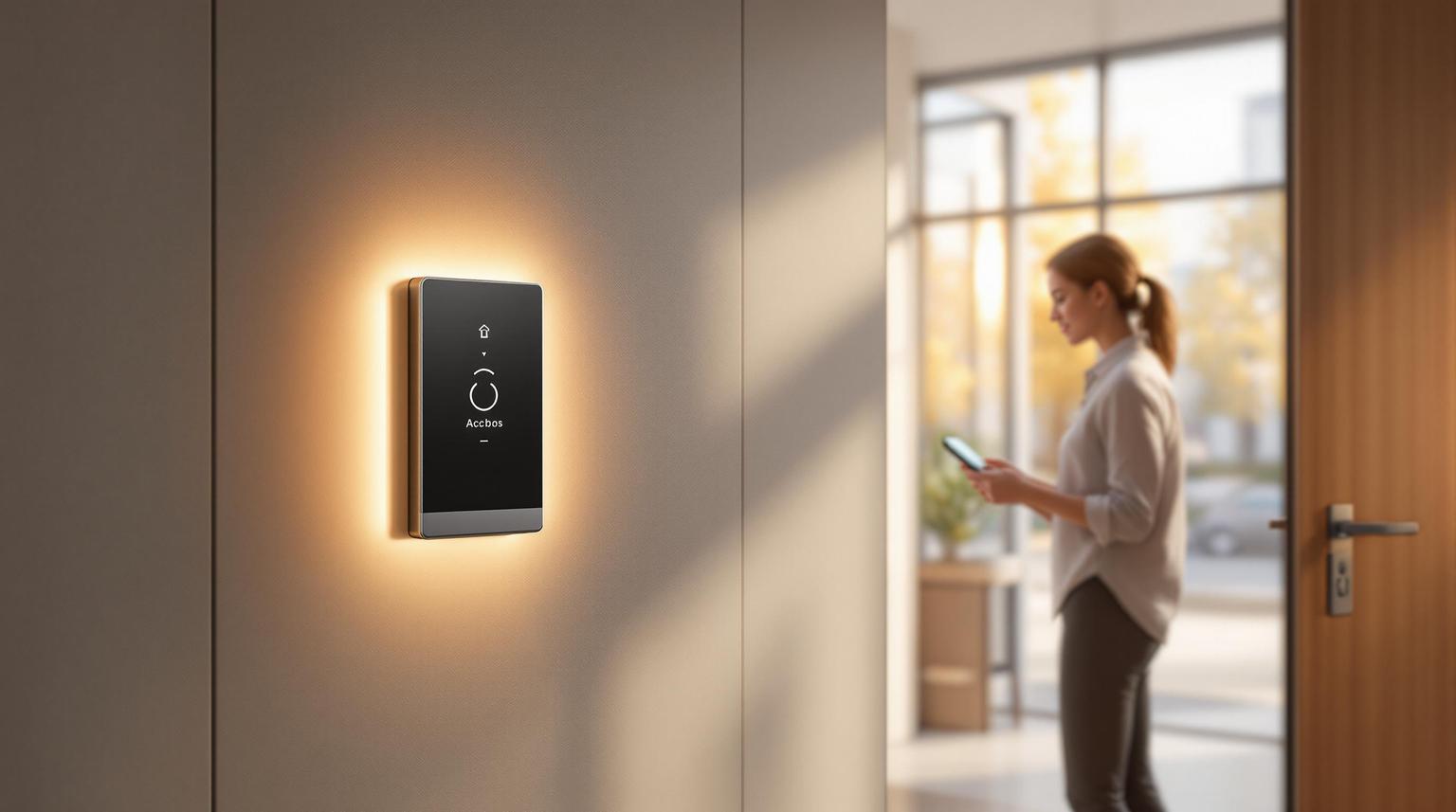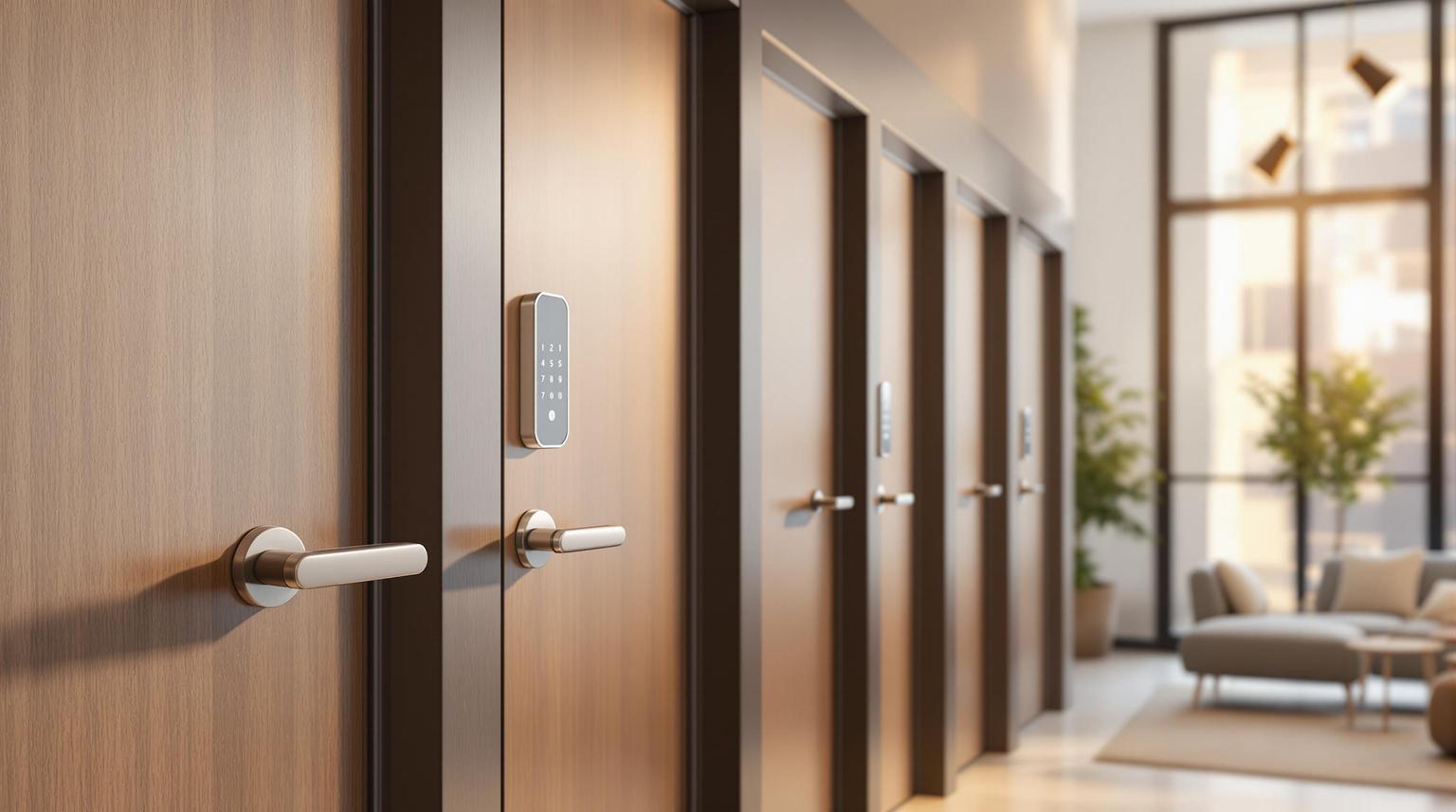Mobile credentials are changing the way residents and property managers handle apartment access. Here's why they're gaining traction:
- Convenience: Residents use smartphones or smartwatches to unlock doors, gates, and shared spaces - no need for physical keys, fobs, or cards.
- Security: With features like biometric authentication and encrypted communication, mobile credentials are harder to lose, steal, or clone compared to traditional keycards or fobs.
- Efficiency for Managers: Access permissions can be updated remotely, saving time and reducing administrative tasks.
- Cost Savings: Eliminates the need for physical replacements and reduces labor costs tied to managing traditional systems.
- Resident Satisfaction: 67% of residents prefer mobile credentials, appreciating the ease of use and added features like temporary guest access.
Quick Comparison:
| Aspect | Mobile Credentials | Keycards/Fobs |
|---|---|---|
| Security | Biometric, encrypted, non-clonable | Can be lost, cloned, or shared |
| Management | Remote updates | Manual reprogramming required |
| Cost Over Time | Lower (no physical replacements) | Higher (frequent replacements) |
| Resident Preference | 67% prefer mobile | Familiar but less favored |
Mobile credentials are gaining popularity because they address common problems with traditional systems while offering modern conveniences.
Mobile Credentials: Unlocking the Future of Access Control
1. Mobile Credentials
Mobile credentials replace traditional physical keys with smartphones, turning them into digital keys. These systems typically use Bluetooth Low Energy (BLE) or Near Field Communication (NFC) through dedicated apps, enabling tap-and-go entry [10]. Instead of juggling physical cards or fobs, residents can simply unlock doors, gates, and shared spaces with their phones. This growing shift toward digital keys raises important questions about their security and efficiency compared to traditional methods.
Security
When it comes to security, mobile credentials outperform traditional access methods. Unlike physical keycards, which can be cloned or stolen, mobile credentials are far more secure. Modern smartphones come with built-in security layers, such as biometric authentication, that physical cards can't match [2]. Two-factor authentication adds another layer by requiring users to unlock their phones - often with a fingerprint or facial recognition - before gaining access [4]. Communication between the device and access point is encrypted, and if a phone is lost or stolen, access can be revoked instantly and remotely [1]. To put it into perspective, 17% of users lose at least one physical keycard or fob annually, a risk significantly reduced with mobile credentials [4][1].
Operational Efficiency
Mobile credentials don’t just enhance security - they make life easier for property managers. With cloud-based platforms, administrators can manage access permissions remotely, from anywhere [5][7]. Tenant move-ins and move-outs become smoother with automated access rights management, allowing credentials to be activated or deactivated instantly [5]. This eliminates the need for time-consuming and costly lock replacements when access is compromised [7]. Centralized management is especially valuable for properties with multiple access points. For instance, at Oxford Vista Apartments, the ProdataKey system manages access across 30 points, including exterior doors and parking gates, improving both safety and convenience for residents [5].
Cost
Switching to mobile credentials can lead to noticeable cost savings. Without the need to produce or replace physical cards, properties save on materials and equipment. There’s no longer a need to stock blank cards, buy encoding machines, or pay for urgent replacements. Administrative labor costs also decrease since property managers spend less time programming cards, tracking lost credentials, or arranging lock changes. Additionally, fewer physical components mean lower maintenance expenses, while the system’s ability to prevent unauthorized access can reduce security-related costs and liabilities.
Resident Satisfaction
Mobile credentials also score high in terms of resident satisfaction. A significant 67% of residents prefer mobile credentials over traditional keys or cards [8]. The convenience of smartphone-based access eliminates worries about losing keys or having unauthorized copies made [9]. Even in the event of a lockout, residents can regain entry quickly without waiting for property staff to assist [9]. With 74% of Americans feeling uneasy without their phones, mobile credentials are less likely to be forgotten [4][1]. The system also allows residents to generate temporary credentials for guests, service providers, or family members. These temporary credentials can be sent via email and used immediately, reducing reliance on property management. Additionally, features like self-touring options for prospective residents further enhance the overall experience [10][9].
2. Keycards and Fobs
Keycards and fobs have long been a go-to solution for access control in multifamily properties. While they offer some advantages over traditional metal keys, they also come with a unique set of challenges for property managers.
Security
Keycards and fobs have some glaring vulnerabilities. They can be lost, stolen, or even cloned - issues that have affected up to 41% of users [2][3]. Adding to the risk, 34% of users admit to lending their credentials to others, further compromising security [3]. In fact, compromised credentials were responsible for 19% of data breaches in 2022 [3]. Unlike smartphones, which often feature biometric authentication and encryption, keycards and fobs lack these advanced security measures. These weaknesses can lead to significant challenges, both in terms of safety and administrative workload.
Operational Efficiency
Managing keycards and fobs is no small task for property management teams. Tracking who has which fob, issuing replacements for new residents, and deactivating old credentials when someone moves out can be a logistical headache [11]. These processes are not only time-consuming but also prone to human error. On top of that, any changes to access permissions require reprogramming, which comes with additional costs - ranging from $25 to $100 per fob - plus technician fees and equipment expenses [11]. Unlike mobile credentials, which can be managed remotely with ease, keycard systems demand hands-on attention.
Cost
The financial burden of keycards and fobs goes well beyond their initial cost. A single fob typically costs between $50 and $100 [11]. For a 200-unit property, replacing just two fobs per unit at $75 each can add up to $30,000 annually. Reprogramming fees, which average $50 per unit, can tack on another $10,000 per year [11]. Over five years, these expenses can exceed $200,000 when factoring in both initial purchases and ongoing costs. Residents also feel the pinch, often paying $50 to $100 to replace lost or damaged fobs [11].
Resident Satisfaction
Despite these drawbacks, keycards and fobs do offer conveniences that many residents value. A single fob can provide access to multiple areas like building entrances, parking garages, and amenities such as fitness centers [13]. This ease of use is appealing, and renters often appreciate the keyless entry experience enough to pay a premium for it [12]. The ability to deactivate lost or stolen credentials quickly also provides some peace of mind.
Interestingly, about 75% of renters express a preference for community-wide access control systems, which often rely on digital credentials like fobs to manage shared spaces [14]. Keycards can also simplify guest access, as property managers can issue temporary credentials for visitors or service providers. However, this process still requires coordination and oversight.
That said, keycards and fobs come with their own set of inconveniences. Residents must remember to carry them, and losing or damaging a fob can result in replacement costs. Access issues may also depend on the management office's availability, and the physical nature of these credentials makes them prone to damage or demagnetization. While they offer a familiar and straightforward way to manage access, their limitations underscore why mobile credentials are becoming a more attractive alternative.
sbb-itb-58157f8
Advantages and Disadvantages
This section delves into the strengths and weaknesses of mobile credentials and traditional keycards or fobs, offering a clear picture of what each system brings to the table.
Mobile credentials stand out for their security and convenience. Smartphones come equipped with features like passcodes, fingerprint scanning, and facial recognition, making these credentials nearly impossible to clone. This significantly reduces the risk of unauthorized access [4]. Many properties using mobile credentials report impressive results, including a 70% drop in key/card replacement costs and a 45% reduction in administrative time [8].
"They're not only more convenient, but they're more secure because physical credentials can be much more easily lost, duplicated, and stolen. But you can't just duplicate a phone, and people don't share their phone the way that they share physical credentials." - Sean Blaisdell, Inside General Sales Manager, ProdataKey [17]
That said, mobile credentials aren't perfect. They rely on smartphones, which can create challenges if a device's battery dies or if there are connectivity issues [18]. Some users, especially older residents, may also feel uneasy with mobile technology and prefer the simplicity of physical credentials [17].
On the other hand, traditional keycards and fobs are familiar and require no smartphone or app. This simplicity appeals to many residents. However, these physical credentials come with notable downsides. They are easily lost or duplicated, and in 2022, compromised credentials accounted for 19% of attack vectors [3]. This vulnerability leads to frequent replacements and reprogramming, adding to administrative workloads.
| Aspect | Mobile Credentials | Keycards/Fobs |
|---|---|---|
| Initial Cost per Door | $2,000–$4,500 [16] | $1,500–$3,500 [16] |
| Monthly Fees | $50–$150 subscription [16] | $30–$100 software licensing [16] |
| Credential Replacement | None (digital) | $5–$10 per card/fob [16] |
| Security Features | Multi-factor authentication, encryption, biometrics [4] | Basic proximity access |
| Cloning Risk | Cannot be cloned [4] | Can be cloned or duplicated |
| Remote Management | Instant remote control [15] | Requires physical presence |
| Annual Loss Rate | Minimal (always with user) | 17% lose credentials yearly [4] |
While mobile systems involve higher upfront costs, they eliminate recurring expenses for physical credential replacements [16]. Over time, these savings - combined with reduced administrative burdens - can make a big difference for larger properties.
"Simply downloading an app, clicking a button, logging in and you're done - it's that easy." - Sean Blaisdell, Inside General Sales Manager, ProdataKey [17]
Choosing the right system comes down to the needs of the property and its residents. Properties geared toward tech-savvy individuals and modern amenities may find mobile credentials a seamless fit. Meanwhile, those serving a broader demographic might lean toward keycards and fobs, despite their long-term costs and security risks.
Conclusion
Mobile credentials have consistently outperformed traditional access methods in key areas like security, operational efficiency, and resident satisfaction. These strengths highlight a growing shift among residents toward digital access solutions. By adopting mobile credentials, properties can establish a secure and efficient access control system that aligns with modern demands.
From a financial perspective, the benefits are equally compelling. With a return on investment achieved in just 18 months and lower maintenance costs thanks to digital management, mobile credentials offer a clear cost advantage over older systems [8].
Beyond cost savings, mobile credentials address critical security challenges. Features like instant remote access revocation, smartphone encryption, and multi-factor authentication create a robust security framework. These capabilities lead to faster lockout resolutions and better management of security incidents, offering both peace of mind and practicality [8].
For property managers weighing their options, the evidence strongly supports mobile credentials as the superior choice. This technology not only resolves the vulnerabilities of traditional systems but also enhances security, streamlines operations, and improves the overall resident experience. Whether managing a tech-forward community or one more rooted in tradition, mobile credentials provide a meaningful upgrade to security infrastructure.
However, successful adoption requires careful planning. Selecting high-quality systems, ensuring they align with specific security needs, and providing thorough training during the transition are essential steps [8][6]. As the multifamily housing industry continues to evolve, mobile credentials are not just an upgrade - they’re a critical step toward meeting the expectations of today’s residents and achieving modern security standards.
FAQs
How do mobile credentials improve security compared to traditional keycards and fobs in apartment buildings?
Mobile credentials bring a higher level of security to multifamily properties by using advanced technologies like encryption and biometric authentication. Unlike traditional keycards or fobs - which can easily be lost, stolen, or duplicated - mobile credentials are linked directly to a resident's smartphone. This connection allows property managers to update or deactivate access in real time, cutting down the chances of unauthorized entry.
By replacing physical keys, mobile credentials also reduce risks tied to misplaced or stolen items. Features such as secure app-based access and multi-factor authentication add extra layers of protection. This modern approach to access control not only enhances safety but also makes life more convenient for both residents and property managers.
How can switching to mobile credentials help property managers save money?
Switching to mobile credentials offers a smarter and more cost-effective alternative to traditional systems like keycards and fobs. Why? For starters, mobile credentials eliminate the need to produce, distribute, or replace physical keys - a process that typically costs between $4 and $25 per unit. Over time, these savings on materials and labor can make a noticeable difference.
Another major advantage is remote access management. With mobile systems, you can issue or revoke access instantly, without requiring on-site staff. This not only reduces the need for security personnel but also simplifies day-to-day operations, cutting down on expenses even further. By transitioning to mobile credentials, multifamily communities can streamline their processes, save money, and boost overall efficiency.
How can property managers address residents' concerns about using mobile technology for access control?
Property managers can address residents' concerns about mobile access control by emphasizing its security features. These include multi-factor authentication, data encryption, and cloud-based management, all of which work together to ensure mobile credentials are both secure and dependable.
It's also important to inform residents about the practical advantages of using mobile credentials. They remove the hassle of dealing with lost keys or fobs, make it easy to manage access remotely, and provide a seamless way to allow entry for guests or service providers. By clearly explaining and demonstrating how the system works, property managers can help residents feel more confident, showcasing how it improves both safety and everyday convenience.


